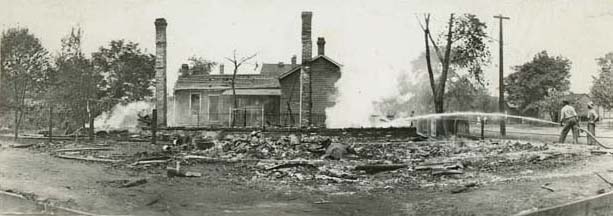Shortly after the September 11 attacks on the World Trade Center and the Pentagon, President George W. Bush announced these as acts of war, and proclaimed a “war on terrorism.” But what exactly was to be the target of this war? And what precisely did the president mean by terrorism? Despite uttering the words “terror,” “terrorist,” or “terrorism” 32 times in his September 20 speech to the nation, he never defined terrorism.

Homes and businesses of African Americans destroyed by white supremacists during Tulsa Massacre of 1921. Why don’t textbooks call this terrorism?
Teachers need to engage our students in a deep critical reading of terms — such as “terrorism,” “freedom,” “patriotism,” and “our way of life”—that evoke vivid images but can be used for ambiguous ends.
I wanted to design a lesson that would get students to surface the definitions of terrorism that they carry around — albeit most likely unconsciously. And I wanted them to apply their definitions to a number of episodes, historical and contemporary, which involved some kind of violence or destruction. I didn’t know for certain, but my hunch was that as students applied definitions consistently, they might be able to call into question the “We’re Good/They’re Bad” dichotomies that have become even more pronounced on the political landscape.

Two men carry children blinded by the Union Carbide chemical pesticide leak to a hospital in Bhopal, India, Dec. 5, 1984. Source: Sondeep Shankar, Associated Press
So I wrote up several “What Is Terrorism?” scenarios, but instead of using the actual names of countries involved, I substituted fictional names. Given the widespread conflation of patriotism with support for U.S. government policies, I had no confidence that students would be able to label an action taken by their government as “terrorism” unless I attached pseudonyms to each country.
. . .
Students read the scenarios and based on the definitions of terrorism that their group came up with, decide:
1. Which of the situations below are “terrorism”;
2. Who are the “terrorists” in the situation; and
3. What additional information you would need to know to be more sure of your answers.
Classroom Story
I use the Zinn Education Project in my classroom quite often. My favorite lesson is entitled Whose “Terrorism”?, which gives students perspective on what terrorism is and how it works. The lesson lets the educator teach from the perspective of the other, which is crucial to the classroom of today. A great resource which I plan on using more.
This lesson was published by Rethinking Schools in a Rethinking Schools Special Report, “War, Terrorism, and Our Classrooms: Teaching in the Aftermath of the September 11th Tragedy.” For more articles and lessons like “Whose ‘Terrorism’?,” visit Rethinking Schools.

















Thank you. I plan to use this in my class tomorrow!
I like your activity. I have created a similar one based more on action of the American Revolution. It is interesting when students discuss events like the Boston Tea Party and excerpts from people like Thomas Jefferson and attempt to determine if the actions are terrorism or the people are terrorists. It is even more interesting when they change their minds once they know the event or person we are discussing.
This may help illustrate this lesson for your students. http://www.theatlantic.com/politics/archive/2012/05/is-one-mans-terrorist-another-mans-freedom-fighter/257245/